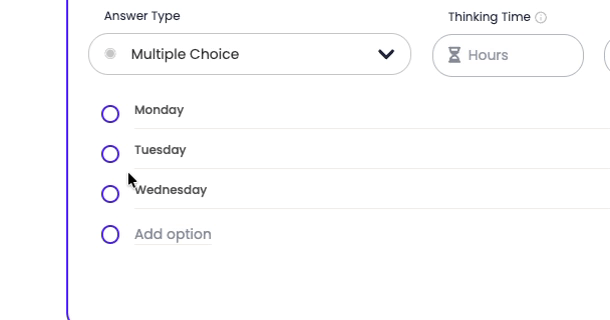Multiple choice questions
Understanding Multiple Choice Questions
Multiple choice questions offer a structured approach to assessing candidates' knowledge, skills, and suitability for a particular role. Unlike open-ended questions, which may yield varied responses, multiple choice questions provide predefined options, allowing for easier comparison and evaluation during candidate assessment and testing.
Multiple Choice Questions are available to all Willo users.

Key Benefits of Multiple Choice Questions:
Objective evaluation: By presenting candidates with a fixed set of response options, recruiters can ensure consistency in assessment criteria across all applicants. This standardization reduces the potential for bias or subjective interpretation, enabling a more objective comparison of candidates' capabilities.
Efficiency: Multiple choice questions save time for both recruiters and candidates. Recruiters can quickly review responses without the need to interpret lengthy or nuanced answers, saving valuable time in the screening and selection process. While candidates can efficiently demonstrate their understanding and skills.
Clarity and precision: The structured format of multiple choice questions promotes clarity and precision in communication between employers and candidates. Recruiters can articulate specific criteria or requirements for the job role through well-crafted questions and response options. This clarity ensures that candidates understand the expectations and can respond accurately, reducing ambiguity and potential misunderstandings.
Scalability and consistency: Multiple choice questions are highly scalable, making them suitable for evaluating large candidate pools efficiently. Whether screening hundreds of applicants or conducting assessments for multiple job openings simultaneously, recruiters can conduct multiple choice assessments with ease. This scalability ensures consistent evaluation across different stages of the hiring process and enhances overall efficiency.
Insightful analysis: The data collected from multiple choice responses can be analyzed to identify trends, assess candidates' proficiency levels, and inform future hiring decisions.
How to navigate to Multiple Choice Questions in Willo
1. Log in to your Willo account
2. Navigate to your interviews
3. Click Create to build your next interview
4. After initial set-up is complete head to questions
5. Click Answer Type
6. Select Multiple Choice
7. Build out your Multiple Choice question using either radio or checkboxes

Willo's free onboarding sessions will cover the basics on setting up an interview, so make sure you have all relevant staff members from your hiring team join an onboarding session.
How to build your Multiple Choice Question(s) in Willo:
Writing the Question:
Craft clear and concise questions that assess relevant skills or knowledge required for the job role. We will remember your questions so you can use them in other interviews too.
Adding Options:
Provide a set of answer choices that cover different aspects related to the question.
- Radio Options - Candidates can only select from 1 option
- Multiple Choice - Candidates can select multiple options
Setting Correct Answers:
Specify correct answers if applicable, especially powerful for assessing knowledge or proficiency where you are looking for specific answers to be selected.

Saving and Reviewing:
Save your question and review its placement within the interview flow to ensure a seamless candidate experience..

Reviewing candidate responses for Multiple Choice Questions
When a new response has been received you can review the responses like any other response in Willo. Navigate to the candidate you wish to review and select the question:

You can also download these responses by clicking Download All. The selections made will be presented to you in a CSV spreadsheet for analysis.
Best Practices for Multiple Choice Questions
✅ Relevance: Ensure that questions are directly related to the job role and assess critical skills or competencies required for success.
🙅 Avoid ambiguity: Write clear and unambiguous questions to avoid confusion and enable candidates to provide accurate responses.
⚖️ Balanced options: Provide answer choices that cover a range of possibilities, avoiding biases towards specific responses.
⚙️ Limit options: Limit the number of answer choices to maintain clarity and prevent overwhelming candidates.
🌏 Inclusive language: Use inclusive language in framing your candidate assessments to ensure that all candidates feel respected and valued. Avoid language that may inadvertently exclude or discriminate against certain groups.
🛫 Pilot testing: Before deploying multiple choice questions at scale, pilot test them internally or with a small group of candidates to identify any potential challenges and refine your approach.
🚀 Continuous improvement: Regularly review and update multiple choice questions based on feedback and evolving job requirements to ensure their effectiveness.
Summary
By incorporating Multiple Choice Questions into your Willo interviews, you can enhance the efficiency, objectivity, and depth of your candidate assessments. Follow the guidelines outlined in this support article to leverage the potential of Multiple Choice Questions.
Should you have any further questions or require assistance, our team is always here to help!
